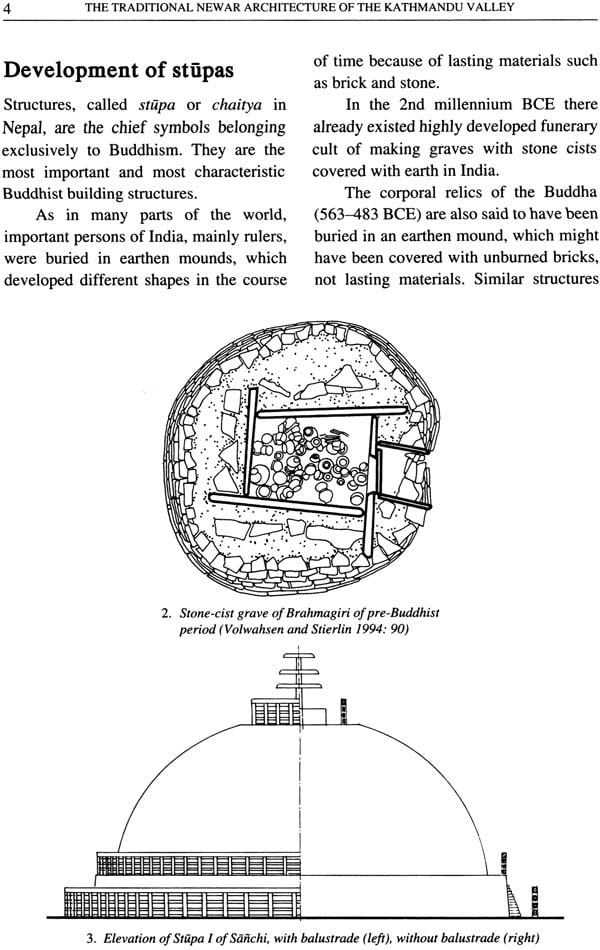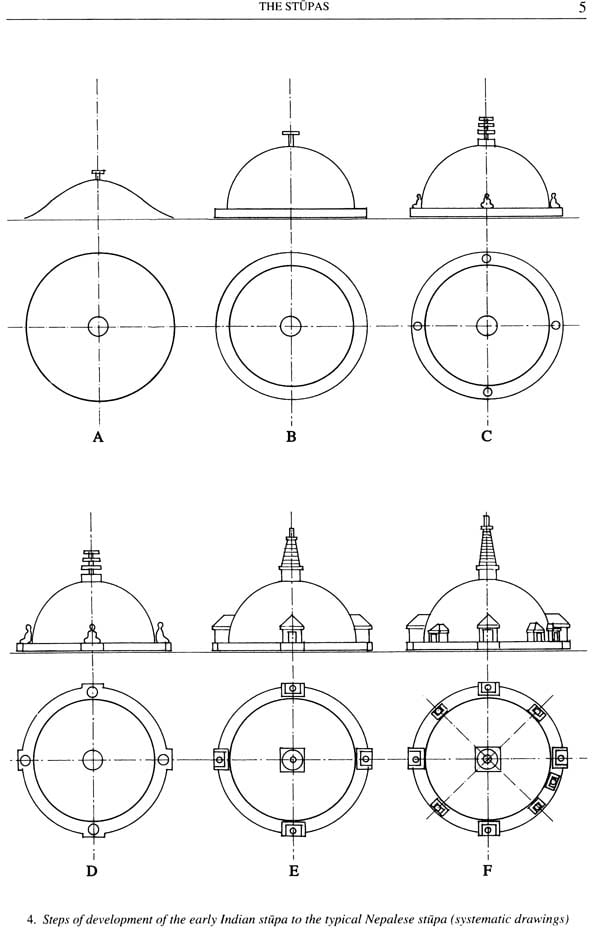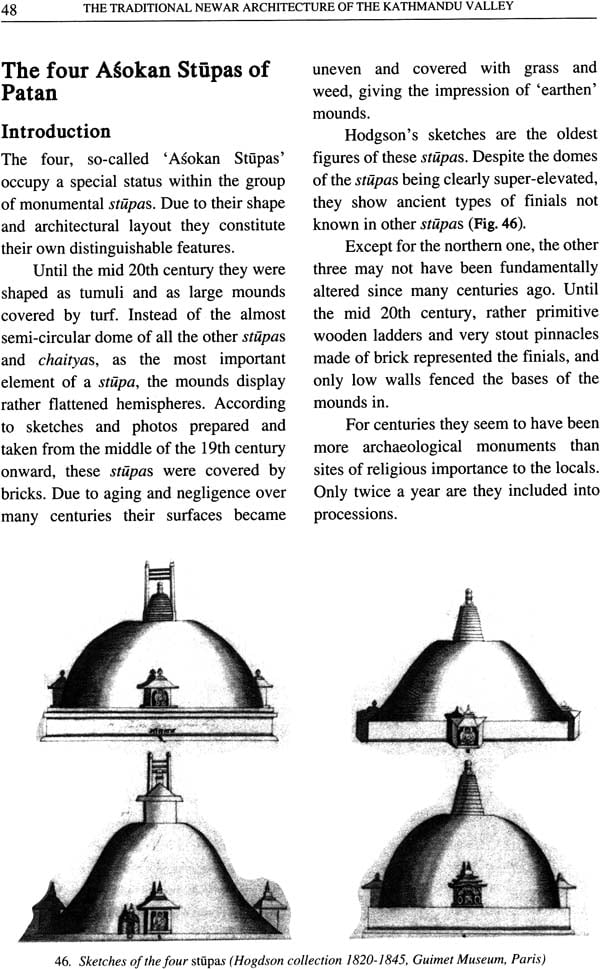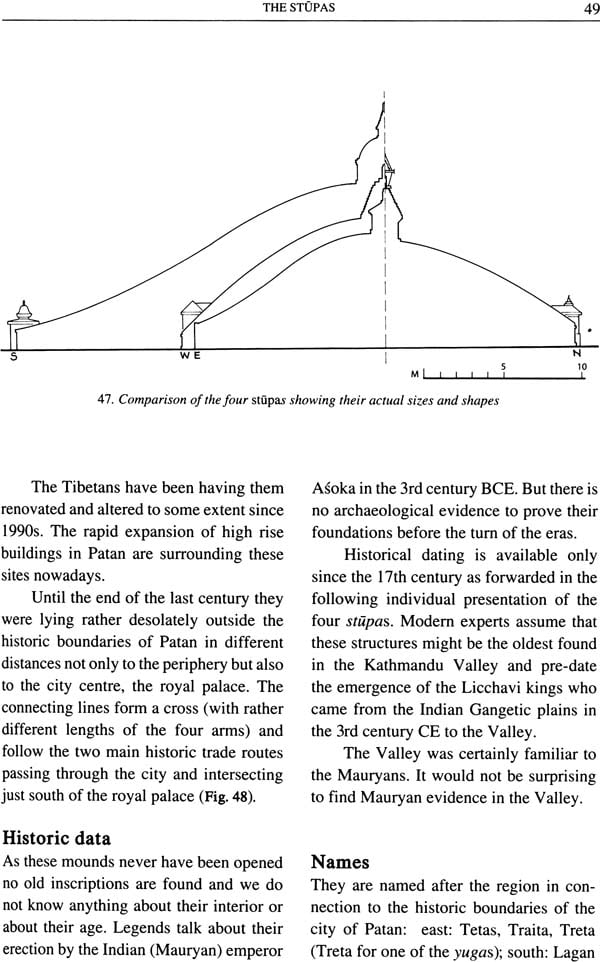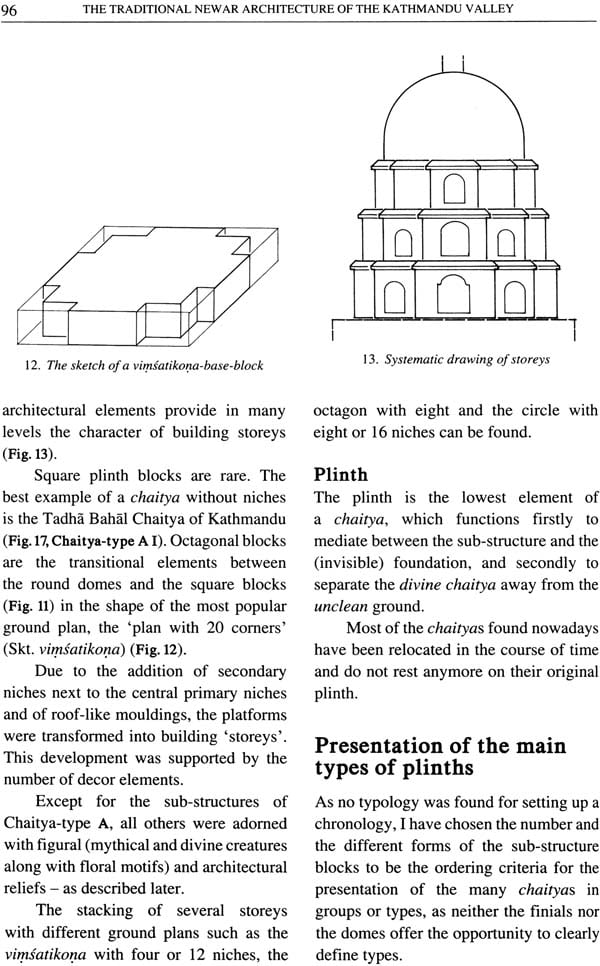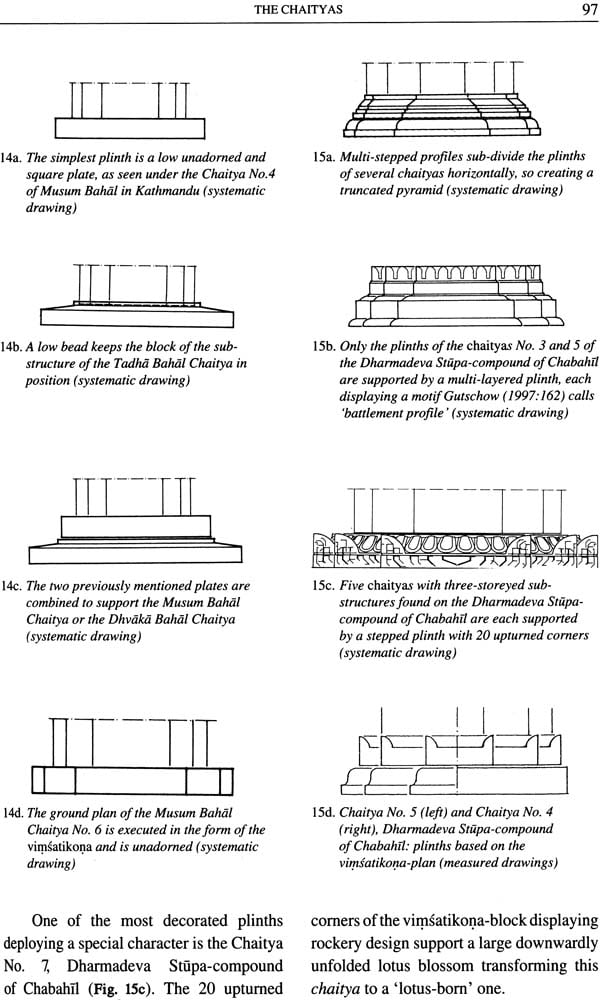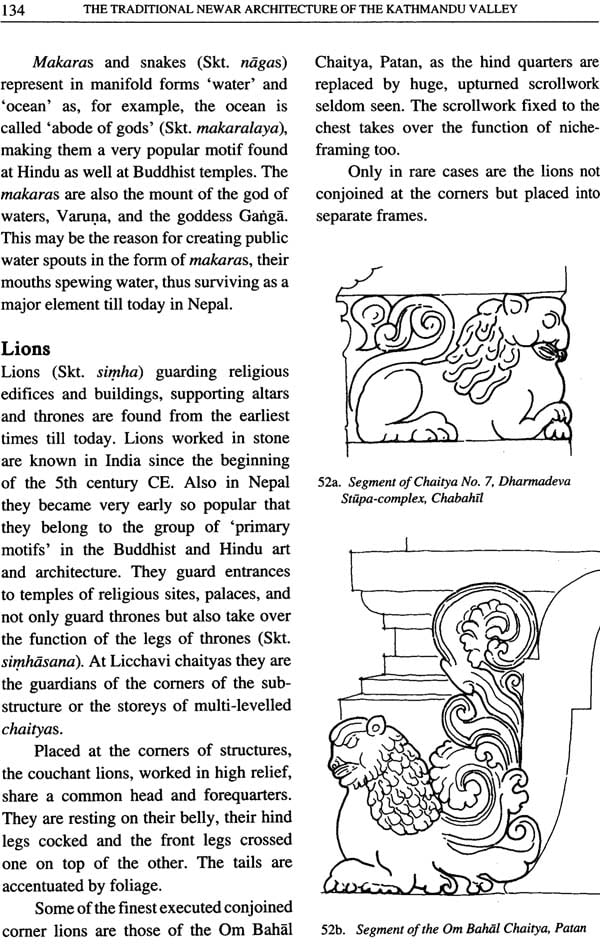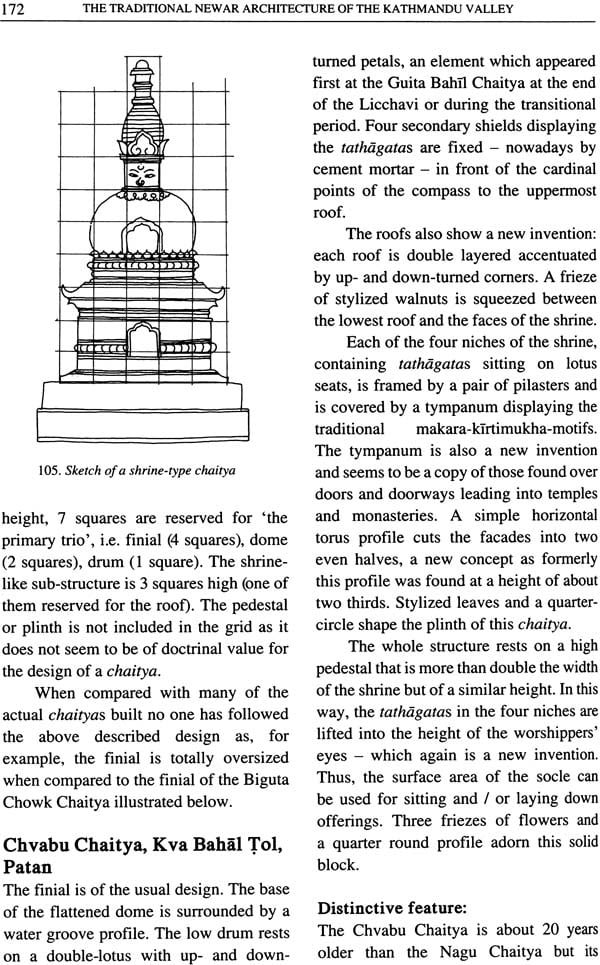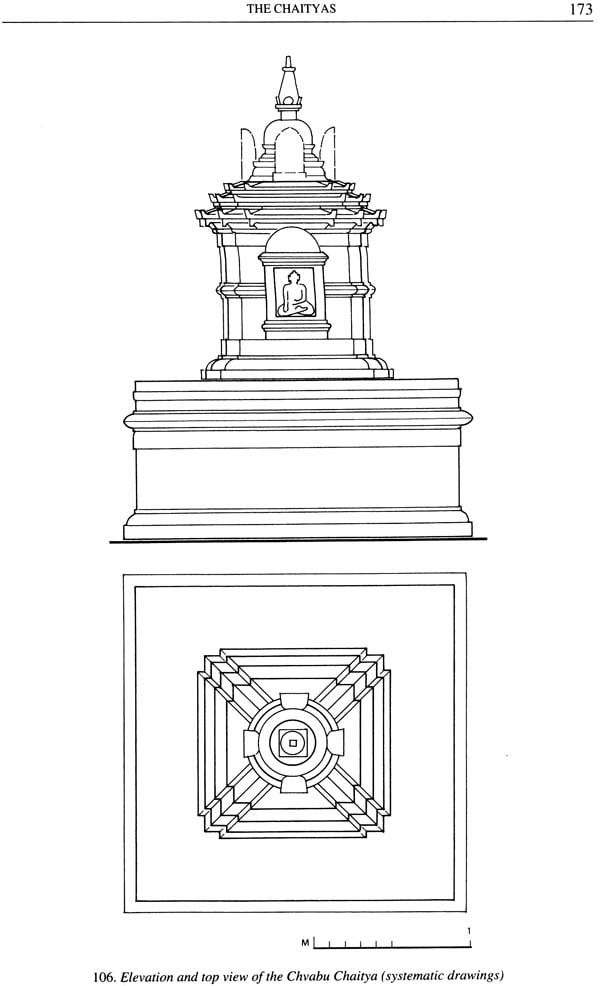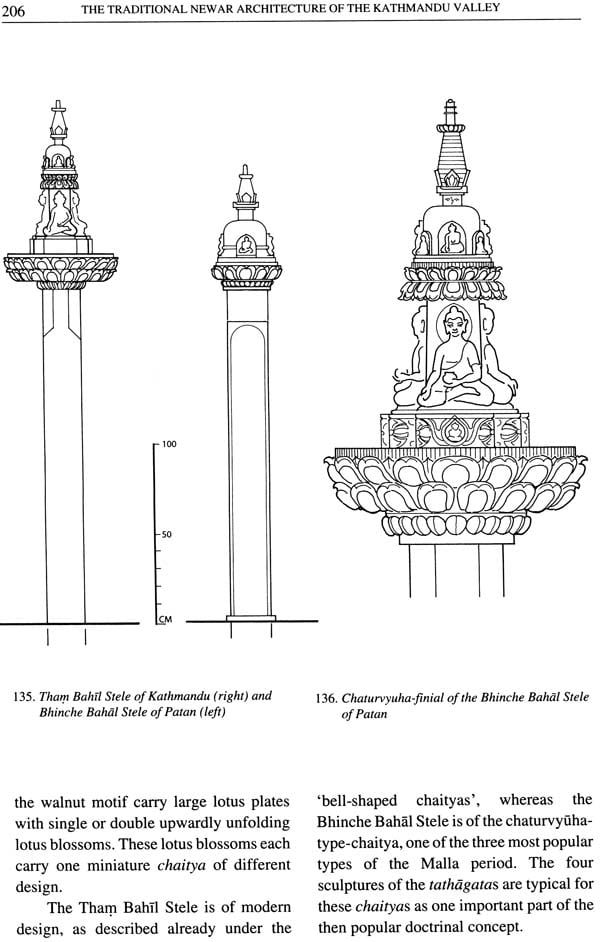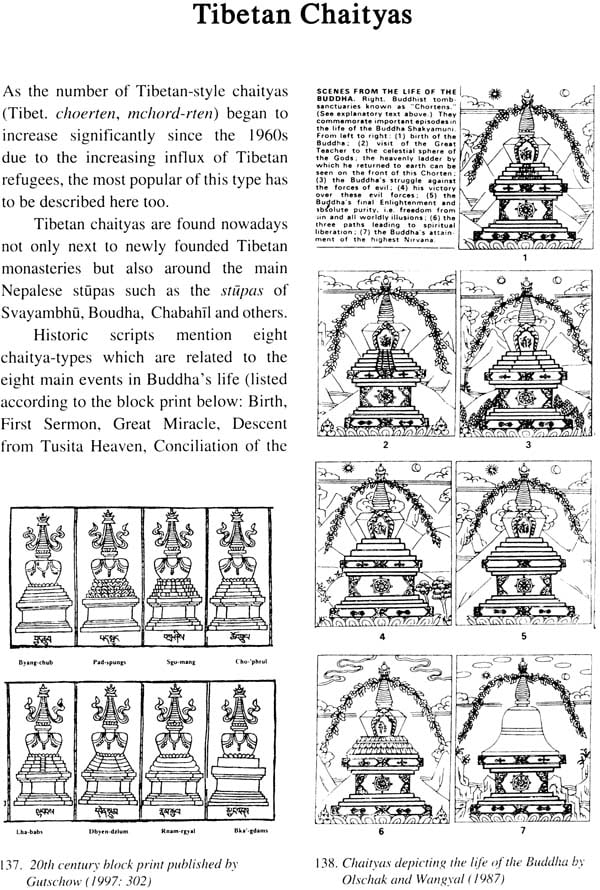
The Stupas and the Chaityas (The Traditional Newar Architecture of the Kathmandu Valley)
Book Specification
| Item Code: | NAM539 |
| Author: | Wolfgang Korn |
| Publisher: | Ratna Pustak Bhandar, Nepal |
| Language: | English |
| Edition: | 2015 |
| ISBN: | 9789937330848 |
| Pages: | 238 (Throughout B/W Illustrations) |
| Cover: | Paperback |
| Other Details | 9.5 Inch X 7.0 Inch |
| Weight | 450 gm |
Book Description
The Traditional Newer Architecture of the Kathmandu Valley: The Stupas and the Chaityas by Wolfgang Korn is the exclusive study of the Buddhist stupas and chaityas- big and small, in the Kathmandu Valley. He describes and demonstrates their various types and site plans with the aid of his own state-of-the-art systematic line drawings. It is a sequel to his two earlier publications entitled The Traditional Architecture of the Kathmandu valley and The Traditional Newar Architecture of the Kathmandu valley: The Sikharas.
Several stupas and chaityas belonging to the periods of Licchavi, Malla and Shah including their distinctive features such as decor elements and building materials are described in the plain language. Religious and legendary monuments such as the Svayambhu Stupa, the Boudha Stupa and the Asokan stupas along with historical information and detailed line drawings are presented.
The Traditional Newar Architecture of the Kathmandu Valley: The Stupas and the Chaityas contribute significantly to the Buddhist power places and their traditional Newar architecture of the Kathmandu Valley. It is indeed the authentic reference for next-generation students and scholars who are working on traditional architecture in general and conservation architecture in particular.
The big earthquake of the 25th April 2015 has made these three publications very useful and handy for those who are involved in the conservation and preservation projects in the heritage sites.
Born in Dessau in 1943, Wolfgang Korn studied architecture at the Art College (Werkkunstschule) in Krefeld from 1964 to 1967. Having completed his professional education he applied with the German Development Service for Nepal.
For the first three months of 1968 he worked for the Physical Planning Section of the Department of Housing and Physical Planning of His Majesty's Government of Nepal where he designed a few government buildings. He went on working as a group leader in the Town Planning Section for surveying all temple sites outside the settlements, the Durbar Squares of the three royal cities as well as other important monument zones published in the 'Physical Development Plan' by the end of 1969. These initial surveys were later extended and incorporated in two volumes published by UNESCO in 1975 - Kathmandu Valley, The Preservation of Physical Environment and Cultural Heritage: Protective Inventory.
In 1970 he published an article on the architecture of the Kathmandu Valley in Germany's most popular architectural magazine, Bauwelt, incorporating the first measured drawing of the Nautale Durbar of the old Kathmandu palace.
With a scholarship of the Rockefeller Foundation in 1970 he prepared drawings of the Indrasattal in Kharpu, the Kasthamandapa and Lakshmi-Narayana Sattal of Kathmandu Durbar Square and also other buildings - many of which Mary Slusser published in her monumental work, Nepal Mandala in 1982. These were the first measured and published drawings of Newar architecture which supported a distinct typology.
His most extensive survey was the one of the Pujarimath in Bhaktapur in 1971. This Hindu priest-house was later restored by a group of architects from Darmstadt, Germany.
From January to April 1972 he worked for the 'Temple Catalogue Project Nepal' documenting all existing temples (pagodas) with a few detailed surveys of temples.
After a short period back in Germany he returned to Kathmandu at the end of July 1973 to join the Hanuman Dhoka Renovation Project in Kathmandu, a project of UNESCO for a period of four years.
Independently he kept on documenting temples, monasteries, palaces, private houses, etc. which allowed him to publish his the first book on Newar architecture, The Traditional Architecture of the Kathmandu Valley in 1976.
In 1979 he joined the State Conservation Office in Hessen, Germany and published the book, Licchavi Caityas im Kathmandu-Tal in German in 2004.
Though he left Nepal in 1978 he continued his research on sikhara-temples as well as stupas/chaityas and prepared all necessary drawings on the basis of the surveys he carried out in 1968 and 1978. The outcomes of these works are The Traditional Newar Architecture of the Kathmandu Valley: The Sikharas and The Traditional Newar Architecture of the Kathmandu Valley: the Stupas and the Chaityas.
The present publication, The Traditional Newar Architecture of the Kathmandu Valley: The Stiipas and the Chaityas by Wolfgang Korn is the trilogy of his two earlier publications, The Traditional Architecture of the Kathmandu Valley and The Traditional Newar Architecture of the Kathmandu Valley: The Sikharas.
Entirely based on his architectural drawings of his own measurements of historic buildings in Kathmandu, his first work, The Traditional Newar Architecture of the Kathmandu Valley published in 1976 is not only one of the works of its first kind on Nepalese traditional architecture but also the reference material for both students and scholars of traditional architecture. His state-of-the-art of drawings have been duly used in the publications such as Nepal Mandala: A Cultural Study of the Kathmandu Valley (1982) by Mary Shepherd Slusser, Newar Towns and Buildings: An Illustrated Dictionary (1987) compiled by Niels Gutschow, Bernhard Kolver and Ishwaranand Shresthacarya, and Nepal: A Guide to the Art and Architecture of the Kathmandu Valley (1994) edited by Michael Hutt.
Korn's second publication, The Traditional Newar Architecture of the Kathmandu Valley: The Sikharas (2014), deals with the sikharas built by the Newars of the Kathmandu Valley, which are considered monuments of classical antiquity. The sikhara architecture is hardly mentioned in the books on Nepalese architecture, let alone its types, building materials or site plans. On the basis of his own systematic and measured line drawings including historical development, this work not only documents them but also describes the different types of the sikharas.
This third publication of Korn's work on The Traditional Newar Architecture of the Kathmandu Valley: The Stupas and the Chaityas is exclusively concerned with the large and small Buddhist monuments. The large ones are called mahachaityas (big chaityas) in the texts written in Sanskrit and the hybrid Newar language. It presents the historical development of stupas or chaityas that are main symbols exclusively belonging to Buddhism. Hence, they are the most significantly characteristic Buddhist building structures. This third work of his on Newar architecture of the Kathmandu Valley is also entirely based on his systematic line drawings of big and small stupas and chaityas including their site plans. It makes a significant contribution to the traditional Newar architecture of the Kathmandu Valley. It is indeed the authentic reference for next-generation students and scholars who are interested in historical architecture in general and traditional architecture in particular.
Content
| Foreword | VII | |
| Brief History of the Kathmandu Valley | IX | |
| | ||
| Introduction | 3 | |
| Monumental Stupas | 22 | |
| Medium and Small Stupas | 62 | |
| Stupas with Special Forms | 76 | |
| Stupas with Pyramidal Sub-structure | 78 | |
| | ||
| Section 1 | The Lichhavis Chaityas | 89 |
| Introduction | 91 | |
| Catalogue of the Chaitya-types | 98 | |
| Decor Elements and Structures Members | 129 | |
| Sites of Lichchhavis Chaityas | 152 | |
| Section 2 | The Transitional Chaityas | 157 |
| Introduction | 159 | |
| Sikharakuta Chaityas | 160 | |
| Section 3 | The Malla Shah Chaityas | 167 |
| Introduction | 169 | |
| Chaturmukha Chaityas | 183 | |
| Lotus Chaityas | 189 | |
| Padmavali Chaityas | 192 | |
| Chaturvyuha Chaityas | 197 | |
| Chaityas with Special Froms | 203 | |
| Tibetan Chaityas | 207 | |
| Biliography | 209 | |
| Index | 213 |
